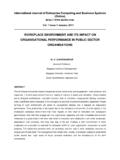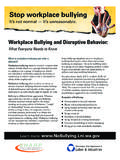Transcription of Workplace violence in the health sector Country case studies
1 Workplace violence in the health sector Country case studies Brazil, Bulgaria, Lebanon, Portugal, South Africa, Thailand and an additional Australian study Synthesis report by Vittorio di Martino 2002- Workplace violence in the health iii Foreword violence at work has become an alarming phenomenon worldwide. The real size of the problem is largely unknown and recent information shows that the current knowledge is only the tip of the iceberg. The enormous cost of violence at work for the individual, the Workplace and the community at large is becoming more and more apparent.
2 Although incidents of violence are known to occur in all work environments, some employment sectors are particularly exposed to it. violence includes both physical and non-physical violence . violence is defined as being destructive towards another person. It finds its expression in physical assault, homicide, verbal abuse, bullying, sexual harassment and threat. violence at work is often considered to be just a reflection of the more general and increasing phenomenon of violence in many areas of social life which has to be dealt with at the level of the whole society.
3 Its prevalence has, however, increased at the Workplace , traditionally viewed as a violence -free environment. Employers and workers are equally interested in the prevention of violence at the Workplace . Society at large has a stake in preventing violence spreading to working life and recognizing the potential of the Workplace by removing such obstacles to productivity, development and peace. violence is common to such an extent among workers who have direct contact with people in distress, that it may be considered an inevitable part of the job.
4 This is often the case in the health sector ( violence in this sector may constitute almost a quarter of all violence at work). 1 While ambulance staff are reported to be at greatest risk, nurses are three times more likely on average to experience violence in the Workplace than other occupational groups. Since the large majority of the health workforce is female, the gender dimension of the problem is very evident. Besides concern about the human right of health workers to have a decent work environment, there is concern about the consequences of violence at work.
5 These have a significant impact on the effectiveness of health systems, particularly in developing countries. The equal access of people to primary health care is endangered if a scarce human resource, the health workers, feel under threat in certain geographical and social environments, in situations of general conflict, in work situations where transport to work, shift work and other health sector specific conditions make them particularly vulnerable to violence . In such situations the best educational system, labour market policies and workforce planning may have little or no impact.
6 The International Labour Office (ILO), the International Council of Nurses (ICN), the World health Organization (WHO) and Public Services International (PSI) launched in 2000 a joint programme in order to develop sound policies and practical approaches for the prevention and elimination of violence in the health sector . When the programme was first established and information gaps were identified, it was decided to launch a number of Country studies as well as cross-cutting theme studies and to conclude by drafting guidelines to address Workplace violence in the health sector .
7 This working paper presents the Synthesis Report of the commissioned Country reports to stimulate further discussion in the area of Workplace violence , encourage fact-finding research in other countries and support sound policy-making. 1 Nordin, H. (1995). Fakta om vaold och hot I arbetet, Solna: Occupational Injury Information System, Swedish Board of Occupational Safety and health . 2002- Workplace violence in the health v Contents Page Foreword .. iii Acknowledgements .. vii Executive summary.
8 Ix 1. Targeting an unknown area .. 1 Original methodology .. 3 Literature analysis (highlights) .. 5 Group discussions and 8 Survey .. 8 2. Definitions, perceptions and cultural 11 3. Society, change and 14 4. A unique new vision .. 16 The dimension of the problem .. 16 Physical and psychological .. 16 Perpetrator and 17 Part of the job?.. 19 Where it 20 5. The origin of Workplace violence : Causes and reasons .. 21 Individual factors .. 22 Societal 22 Organizational 23 6.
9 Assessing the impact of Workplace 26 The magnifying cycle 26 The cost for the organization .. 27 7. Building an effective response .. 29 Reporting .. 29 Strategic or immediate? .. 30 32 8. Recommendations from the Country studies .. 34 9. Critical issues .. 39 Appendix List of documents .. 41 2002- Workplace violence in the health vii Acknowledgements The Joint Programme wishes to thank the author of this Synthesis Report: Vittorio Di Martino, an international consultant specializing in health and safety at work, enterprise development and organizational well-being.
10 He has been responsible for the programmes on stress and violence at work at the European Foundation for the Improvement of Working and Living Conditions, Dublin, and at the International Labour Organization, Geneva, from 1980 to 2001. This report is based on the Country reports conducted in the various countries. In each Country the case studies have been carried out with sincere commitment and engagement of the researchers and their teams. The Joint Programme wishes to thank all persons involved for their valuable contributions.


















